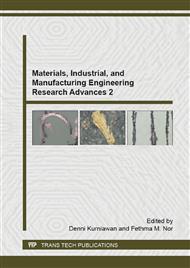p.426
p.432
p.437
p.441
p.445
p.450
p.455
p.460
p.465
Effect of Heat Treatment on Surface Morphology of Titanium
Abstract:
Alkali and heat treatments were first introduced by Kim et al. to prepare a bioactive surface on titanium. This method has been proven very effective and widely used in biomaterial researches to promote titanium osteointegration. This study aims to investigate further the effect of heat treatment on surface morphology of high purity titanium. High purity titanium foils were immersed in 5 M NaOH at 60°C for 24 hours followed by heat treatment at 400°C, 500°C, 600°C, 700°C and 800°C for 1 hour in air atmosphere. The surface morphology was examined using Field Emission Scanning Electron Microscope (FESEM). The surface topography and surface roughness were obtained using Atomic Force Microscopy (AFM). A structure transformation accompanied by significant grain growth were observed as temperature increased from 400°C to 800°C. As temperature increased, the grain coarsened and became larger in size which is in good agreement with the increasing surface roughness. A sudden decrease in surface roughness of titanium at 800°C might be due to the spallation of oxide layer.
Info:
Periodical:
Pages:
445-449
Citation:
Online since:
October 2015
Keywords:
Price:
Сopyright:
© 2015 Trans Tech Publications Ltd. All Rights Reserved
Share:
Citation:


